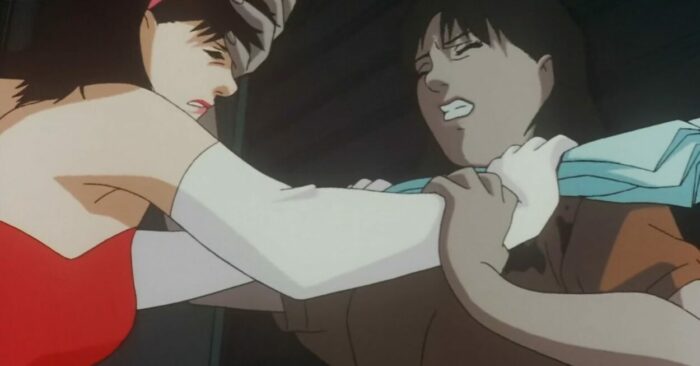The opening of 1998’s Perfect Blue is like countless other anime from that era: a group of colorful Kamen rider-styled heroes locked in battled with one of their countless foes. But it’s no more than a minute before the camera pulls back to reveal it’s just a group of actors giving an on-stage performance—one that its audience notes looks cheap and nothing like what they’ve seen on TV. Pay attention to that particular trick: it’s one that Perfect Blue will pull time and time again—and the beauty of it is, you’ll fall for it every single time.
In the twenty-five or so years since the film was first released (it debuted at a film festival in 1997 but didn’t see widespread release until around February of 1998), Perfect Blue hasn’t lost a single ounce of its power. If anything, it’s become more profound and provocative than ever, an intense examination of the relationship between audience, performer, and performance—and the ugly consequences of what happens when the lines in that relationship become blurred.
Visually, Perfect Blue is very much in line with the style of late ‘90s anime, functioning as a time capsule of sorts for what is arguably the peak period of the medium—this is the period that gave us such iconic works as Neon Genesis Evangelion, Cowboy Bebop and Princess Mononoke. Every face is unique and speaks to each particular character from the almost Disney Princessesque softness of Mima to the hard-edged sleaze of her agent, every environment is gorgeously realized, and there’s a genuinely sickening bite to the film’s moments of stomach-churning violence.

But a large part of what set Perfect Blue apart from its contemporaries is the manner in which director Satoshi Kon and his creative team constantly use the boundaries of the medium against us in the audience to manipulate our perception and sense of reality. Time and time again, scenes will play out to anxiety-inducing effect only for a voice yelling “cut!” or the whole scene being rewound on a VCR to reveal them to simply be scenes being filmed for Double Bind, the in-universe TV show Mima is working on. Certain lines echo throughout different scenes with their context growing ever more sinister. In one memorable moment, a scene plays out twice, simply switching between the names of the characters in Double Bind and those of the victims of the attacks that are seemingly getting closer and closer to Mima herself.
The other side of how Perfect Blue differs from most other anime is its themes, more along the lines of iconic psychological thrillers such as Vertigo or Blue Velvet than what you would find in, say, Pokemon. The struggle that heroine Mima faces in Perfect Blue after leaving her pop idol career behind to try and make it as an actress is not simply one for her life or her psychological well-being, but also for both her autonomy and her very identity. As we see throughout the film, Mima has relatively little control over her life and career. But where something like Mulholland Dr. constructed a shadowy underworld of powerful men pulling strings, Perfect Blue presents us with a simultaneously far more mundane and far more horrifying reality: middle-aged men and women in a drab office building, debating whether or not Mima should take on a role that includes a rape scene as though it were no different than deciding what outfit she should wear to a premiere.

Mima certainly faces a very real and present danger from her deranged pair of stalkers, but Perfect Blue’s true conflict is ultimately between her and the idol persona she’s performed under for years. As she attempts to separate herself from that persona, it feels like it’s taking on a life of its own, both through the website that Rumi is using to try and pose as Mima and through the vivid hallucinations that Mima starts to suffer from as her grip on reality loosens. On the other side of the coin, while Rumi and Me-Mania’s behavior is certainly extreme and heightened by mental instability on both of their behalf, it’s rooted in something that’s become all too relatable: an obsession with Mima’s idol persona, one that has grown to the point of not simply being the illusion of a connection with her, but what almost feels like a sense of entitlement to keep that illusion maintained. The two of them see Mima’s idol persona as the “real” version of her, and they’re more than willing to destroy the person behind the persona to try and keep said persona alive, whether that’s trying to gaslight her into thinking she’s responsible for the increasingly violent attacks or by outright killing her.
Parasocial relationships—ones in which media users develop illusions of intimacy, friendship, and identification with celebrities or personas—and celebrity obsession are hardly new phenomena. But they are phenomena that have become much more prominent in recent years, in large part due to the rise of platforms like Twitter and Twitch. Not only is there an even greater illusion of connectivity to more traditional celebrities, but there’s also now a whole new breed of influencers and streamers whose platforms are directly built on the idea of fostering these kinds of relationships. Perfect Blue might have originally been specifically about the Japanese idol industry—which itself has faced years of criticism for selling its performers on the illusion of accessibility among other things—but there’s a growing universality to these themes as the parasocial relationships being encouraged seemingly grow more and more central to our entertainment.

Stories of these parasocial relationships turning sour are seemingly found everywhere, sometimes funny, sometimes tragic: a Twitch moderator growing angry that the streamer he was donating to had a husband after he thought she was flirting with him, a Japanese idol being attacked by a fan after she returned gifts he had sent her, Taylor Swift facing backlash from her conservative fanbase after endorsing Democratic candidates—one could even argue that John Hinckley Jr.’s attempted assassination of Ronald Reagan lies in this same ballpark, as it was an attempt to impress actress Jodie Foster.
In a very real way, we take the image that a particular performer presents us with and fill in the blanks, creating our own image of that individual the way we want them to be. Then, when something happens that is out of line with that image, some people are so emotionally involved that it can genuinely feel like a betrayal. Real-life cases of violence are thankfully few and far between and generally involve some manner of mental illness on behalf of the attacker, but there’s something to be said about how this sense of fostering parasocial relationships is seemingly growing more and more widespread in entertainment—and possibly growing more and more dangerous. In that sense, Perfect Blue is a film ahead of its time, as both a masterpiece of 90’s anime and a beautifully horrifying tale of celebrity obsession run amok.




